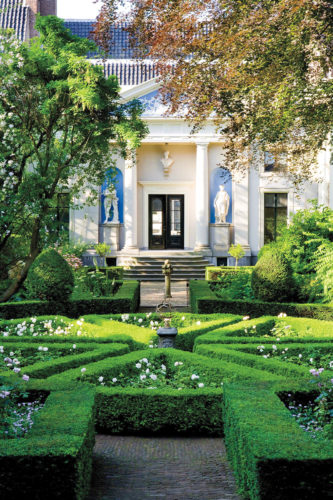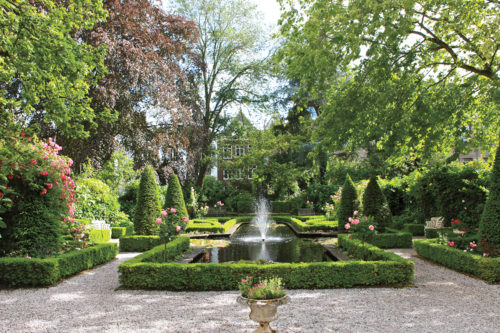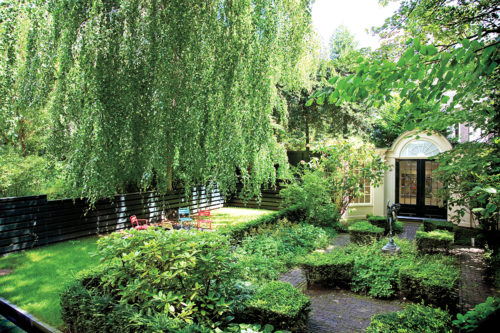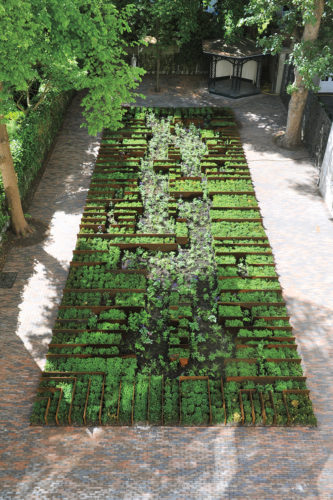Gardeners looking for inspiration flock to Open Garden Days, the annual showcase of Amsterdam’s canal house gardens around June’s summer solstice, when the air is soft and daylight lingers. “People come from all over the world,” says Tonko Grever, director of Museum van Loon and the principal organizer of the event. Open Garden Days happens in June over several days, but if you can’t make the weekend event, canal museum gardens, many of which have been on the tour, welcome guests during operating hours all year. “The canal museum gardens offer a wonderful visiting option without the crowds,” says Grever.
Museum gardens flaunt their individual legacies, designs, ornaments, and vegetation. Although none have been able to wade through the centuries as they were originally conceived, all are magnificent in every season, when visitors are welcome to stroll the paths and tarry on the benches as long as they wish.
Museum van Loon | Keizersgracht 672
Museum van Loon was built circa 1672 and was once home to Ferdinand Bol, a student of Rembrandt. In 1884 it became home to the van Loons, members of the exclusive regent class and whose family cofounded the Dutch East India Company. It opened to the public in 1973 to showcase the family’s four centuries of collections including portraits, silver, china, and furniture. The formal garden is a vision of symmetry with a central, partitioned circle of sharp hedges brimming in summer with pale-pink ‘Gruss an Aachen’ roses. It also features perennials and mature shrub borders, a period sundial, and a massive, 130-year-old red copper beech. Beyond the second terrace, a coach house boasts a charming tearoom and statues in bright-blue bays.

Museum Geelvinck Hinlopen Huis | Keizersgracht 633
This place is devoted to the conservation of its 17th-century house and the display of art and objects in period rooms. The garden stretches from the Herengracht to the Keizersgracht, and the rear is a shady refuge of diamond-shaped box trees and blooming plants that leads to an expansive garden anchored by a cross-shaped pond with a fountain.

Huis Marseille | Keizersgracht 401
This former residence of a merchant who traded goods on the French Riviera is distinguished by a plaque depicting Marseille harbor. Such plaques were common identification tools in the 17th century, long before houses had street numbers. Today the museum collects and conserves contemporary photography and stages four annual exhibitions. The symmetrical garden of mainly evergreens thrives under an arching maple tree, while a sculpture of Hermes, Greek god of commerce, is an appropriate mascot.

Biblical Museum | Herengracht 366
Taking up two side-by-side buildings, this museum is filled with historic bibles, religious objects, and archaeological finds. Gleaning inspiration from the Bible, contemporary garden designer Arend Jan van der Horst made water the fundamental theme. The garden features a classical terrace, spacious pond, and an exhibition space enclosed by high yew hedges. Two outbuildings serve as fragrance cabinets where biblical scents such as incense, mulberry, fig, Judas tree, and oleander may be sampled.
Museum of the Canals | Herengracht 386
This double-width townhouse was once home to 18th-century banker Jan Willink who provided funds to support American Revolutionary War efforts, solicited by envoy John Adams. View the interactive multimedia exhibit of 400 years of canal history before strolling the garden, a dramatic low grid of steel partitions filled with box trees and flowering trees.

Museum of Bags and Purses | Herengracht 573
A thoughtfully restored 17th-century residence serves as the backdrop for the display of more than 5,000 bags and purses. Comprising five centuries of history, the collection was amassed by Hendrikje and Heinz Ivo. The museum’s cafe overlooks the garden of four terraces of espaliered pear and box trees as well as flowering plants in blue, white, and pink.
Museum Willet-Holthuysen | Herengracht 605
This elegant museum was built around 1685 and houses the vast collections of the Willet-Holthuysen family. The garden, an 18th-century French formal design of box parterres, statues, and sculpture, changes seasonally with a spring planting of bulbs and summer installation of annuals.

Hermitage Museum | Amstel 51
The classical Dutch building, named the Amstelhof, was built circa 1681 as a women’s nursing home on the Amstel River. Today, as one of the largest 17th-century buildings in Amsterdam, it houses a branch of St. Petersburg’s State Hermitage Museum. The courtyard garden features two former bleachfields from days when laundry was whitened on the lawn. In the back, a lane of plane trees and parterres with pots is made for a stroll.
View the full story on Amsterdam’s Secret Gardens.
By Marion Laffey Fox | Photography by Tom Elst | Originally published in Flower Magazine, May/June 2015
